Smart Seat Belt Technology Market Insights, 2031
The global smart seat belt technology market was valued at USD 19.3 billion in 2021, and is projected to reach USD 36.8 billion by 2031, growing at a CAGR of 6.5% from 2022 to 2031.
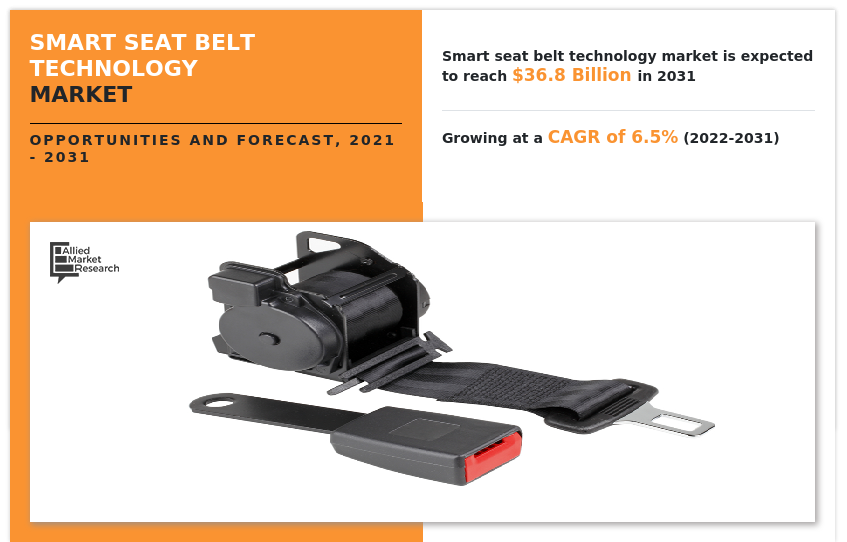
The smart seat belt technology market is segmented into Type, Sales Channel, Vehicle Type and Propulsion.
Smart seat belts are referred to the seat belts with modern technology that endeavor to enhance safety feature of an automobile. Currently, smart seat belts are launched that automatically tighten prior to the accident, thereby minimizing the risk of injury. For instance, ZF Friedrichshafen AG developed Active Control Retractor (ACR) technology which provide driver alerts through a vibration of the seat belt if the vehicle moves out of lane or it gets too close to another vehicle.
Factors such as increase in consumer awareness toward automotive safety and increasing number of road accidents are anticipated to boost the growth of the global smart seat belt technology market during the forecast period. However, high initial cost & complex structure and software failures associated with automotive sensors are expected to hinder the growth of the global market during the forecast timeframe. Moreover, surge in automotive safety norms, and increase in vehicle production in developing countries is expected to create an opportunity for the smart seat belt technology industry in near future.
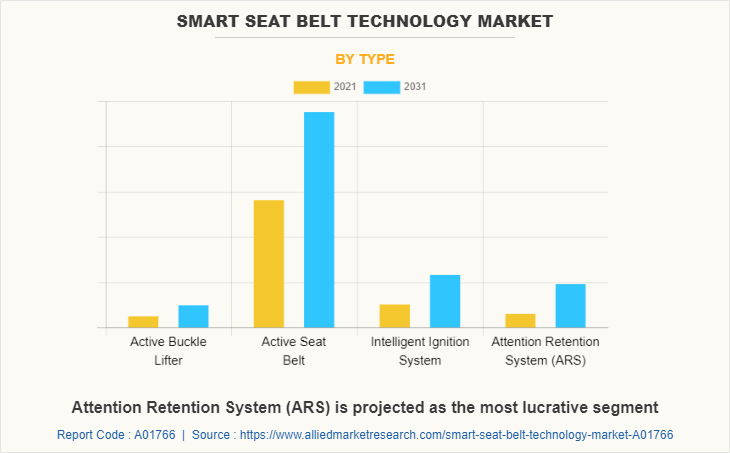
The smart seat belt technology market is segmented on the basis of type, sales channel, vehicle type, propulsion, and region. By type, it is divided into active buckle lifter, active seat belt, intelligent ignition system, and attention retention system (ARS). On the basis of sales channel, it is segmented into original equipment manufacturer, and aftermarket. By vehicle type, it is divided into passenger vehicles, light commercial vehicles, and heavy commercial vehicles. By propulsion, the market is divided into ICE, electric & hybrid, and alternate fuel vehicle. By region, the market is analyzed across North America, Europe, Asia-Pacific, and LAMEA.
The key players that operate in this smart seat belt technology market are Autoliv Inc., Ashimori Industry Co., Ltd, BYD Company Ltd., Continental AG, DENSO Corporation, Far Europe Inc., GWR Safety Systems, Hyundai Mobis, ITW Safety, JOYSON, TOKAIRIKA, CO, LTD., Yanfeng, and ZF Friedrichshafen AG.
Increase in consumer awareness toward automotive safety
Road accidents are a significant concern worldwide, especially when driving on roads with heavy traffic & terrible weather conditions. According to World Health Organization, globally 1.25 million people die in road accidents each year. Over the past few years, the lifestyle of the consumers has become hectic with unfavorable driving protocols witnessed, such as surfing, messaging, and speaking on the phone while driving, which eventually results in automotive accidents. However, to improve the overall vehicle safety to reduce the number of collisions, governments worldwide are increasingly focusing on implementing regulations that demand the development and incorporation of safety systems integrated with sensor systems and cameras in the automobile. This will increase the demand for active seat belt systems, which will help the market to grow in the coming years. In addition, in 2019, Hyundai Mobis launched a new safety technology integrated with ECUs for both electronic seatbelts & airbags that protect passengers through interworking with the autonomous driving sensor. Thus, passenger vehicle registration and increased consumer awareness toward automotive safety are expected to drive the active seat belt system, which is in turn is expected to propel the demand for smart seat belt technology market.
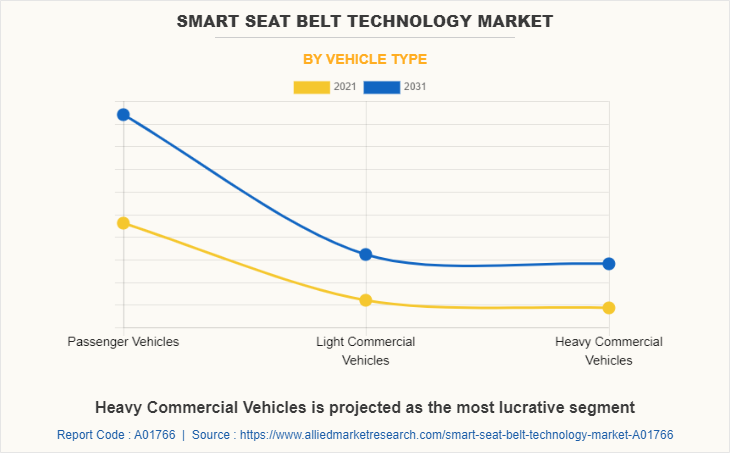
Increasing number of road accidents
Despite the rapid development of automotive industry owing to their various advantages and advancements, the increase in risk of road accidents for riders often becomes a factor limiting the use of vehicles. Yearly, millions of drivers encounter crashes in the U.S. alone. According to data publicized by the National Highway Traffic Safety Administration (NHTSA), a total of 6,756,000 police-reported motor vehicle traffic crashes were recorded in 2019. As the report states, the use of these vehicles is the most dangerous way to travel on roads, and in the European Union, more than 6,500 two-wheeler riders die every year in Europe, and the risk of death for drivers is 20 times that of the passengers. However, several initiatives and campaigns are being proposed to endorse using seatbelts and take other preventive measures to help manufacturers overcome this limitation. The recent boom in the development of driver assistance technology is expected to improve the safety of customers in the near future. The use of advanced safety features to reduce risks are expected to fuel the demand of smart seat belt technology market for during the forecast period.
High initial cost and complex structure
The high cost associated with installing of safety applications in vehicles is expected to reduce the growth of the smart seat belt technology market as it increases the cost of the car. Factors such as higher cost involved with the installation of sensors associated with smart seat belt technology leads to higher cost of cars. Moreover, smart seat belts provide more features such as pretension, buckle lift, and enhanced safety over passive seat belts, their cost is high compared to passive seat belts.
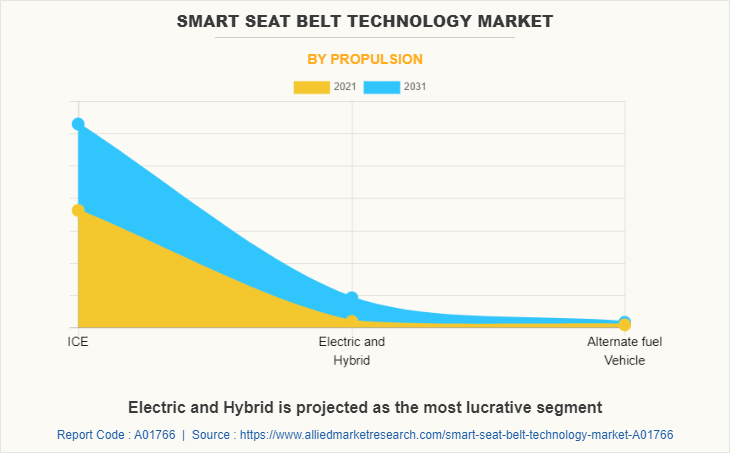
Moreover, smart seat belts provide more features such as pretension, buckle lift, and enhanced safety over passive seat belts, their cost is high compared to passive seat belts. The prospects of providing premium features in vehicles incurs additional expenses to consumers in the form of hardware, applications which eventually hamper the growth of the market. In addition to this, the serviceability of such technology is difficult and requires skilled workers due to several electronic components and sensors. Complex structure of these systems reduce the shelf life of vehicles. Thus, high initial cost and complex structure of advance application may create a negative impact on the growth of the smart seat belt market.
Surge in automotive safety norms
The vehicle's safety plays a crucial role in averting the crash or reducing the impact. Hence, vehicles equipped with such safety standards are least likely to cause significant injury to the occupants. Furthermore, the automotive industry is at its tipping point with increased urbanization, ever-evolving developments of automotive advancements, customer demand for connectivity, and the transitions of vehicles to electric vehicles. Thus, the automotive industry is set to transform with changing market dynamics and increased safety norms. In 2020, the Finance Ministry of India proclaimed a $266 billion stimulus package to revive and lift the automotive industry's decline. In India, according to Bharat New Vehicle Safety Assessment Program (BNVSAP) program, from April 2021, front passenger airbags have become mandatory for every vehicle sold in India, driver and co-driver seat belt alarms must be active till the seats are occupied, and speed warning systems are activated at two levels; at the vehicle exceeding the speed of 80km/hr and 120km/hr. Thus, the modification & implementation of automotive safety norms drive the smart seat belt technology market.
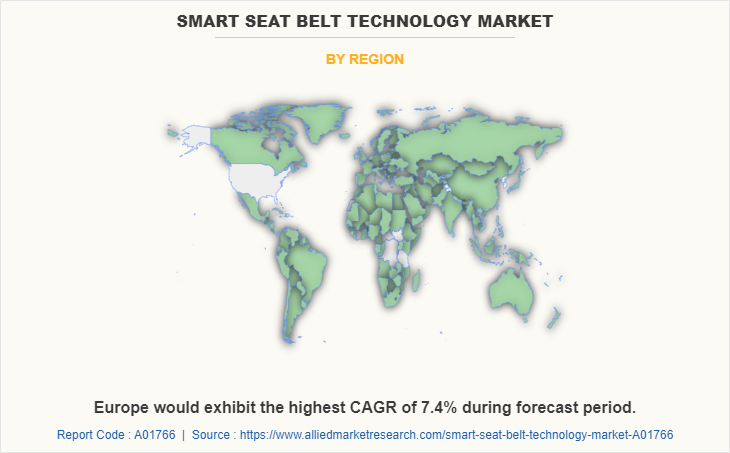
Key Benefits For Stakeholders
- This report provides a quantitative analysis of the market segments, current trends, estimations, and dynamics of the smart seat belt technology market analysis from 2021 to 2031 to identify the prevailing smart seat belt technology market opportunities.
- The market research is offered along with information related to key drivers, restraints, and opportunities.
- Porter's five forces analysis highlights the potency of buyers and suppliers to enable stakeholders make profit-oriented business decisions and strengthen their supplier-buyer network.
- In-depth analysis of the smart seat belt technology market segmentation assists to determine the prevailing market opportunities.
- Major countries in each region are mapped according to their revenue contribution to the global market.
- Market player positioning facilitates benchmarking and provides a clear understanding of the present position of the market players.
- The report includes the analysis of the regional as well as global smart seat belt technology market trends, key players, market segments, application areas, and market growth strategies.
Smart Seat Belt Technology Market Report Highlights
| Aspects | Details |
| By Type |
|
| By Sales Channel |
|
| By Vehicle Type |
|
| By Propulsion |
|
| By Region |
|
| Key Market Players | Joyson Safety Systems,, Yanfeng, ZF Friedrichshafen AG, Samsong, HYUNDAI MOBIS, Autoliv Inc., ITW Safety, GWR Safety Systems, TOKAIRIKA, CO, LTD., CONTINENTAL AG, Ashimori Industry;Co., Ltd, DENSO CORPORATION, Far Europe Inc., GWR, FinDreams (BYD) |
Analyst Review
The smart seat belt technology market is expected to witness significant growth, due to an increase in automotive safety norms & regulations, growth in consumer awareness toward automotive safety, rise in demand for luxury vehicles, and high incidence of road accidents. Furthermore, the growth in the number of vehicle production of luxury vehicles and the availability of multiple options provided by semi-luxury vehicles with more advanced features present opportunities for the smart seat belt technology market globally.
Factors such as increase in consumer awareness toward automotive safety and increasing number of road accidents are anticipated to boost the growth of the global smart seat belt technology market during the forecast period. However, high initial cost & complex structure and software failures associated with automotive sensors are expected to hinder the growth of the global smart seat belt technology market during the forecast timeframe. Moreover, surge in automotive safety norms, and increase in vehicle production in developing countries is expected to create an opportunity for the smart seat belt technology market in near future.
The demand for smart seat belt technology system is directly influenced by the automotive production and sales activities across the globe, as automotive seat belt system is one of the key components of the modern vehicles for improved safety. Moreover, in the modern vehicles, automotive OEMs are inclining toward smart technology to cater to the changing demand for end users, which in turn support the growth for smart seat belt technology market.
To fulfil the changing demand scenarios, market participants are concentrating on product launch and product developments to offer a diverse range of products and meet new business opportunities. For instance, in September 2019, Hyundai Mobis launched a new safety technology integrated with ECUs for both electronic seatbelts & airbags that protects passengers through inter working with the autonomous driving sensor. Moreover, in October 2020, Yanfeng, a leading global automotive supplier launched XiM21 Smart Cabin capabilities for future vehicle interiors. This smart cabin integrated with safety features including early warnings for either system can be communicated with lighting, vibrations in the steering wheel and seat, and automatic seat belt-tightening. In addition, market participants are continuously focusing on collaboration strategy to match changing end-user requirements and improve their presence. For instance, in November 2021, Autoliv Inc. collaborated with global steel company SSAB, to produce the world’s first fossil-free steel components for automotive safety products, such as airbags and seatbelts.
The key players that operate in this market are Autoliv Inc., Ashimori Industry Co., Ltd, BYD Company Ltd., Continental AG, DENSO Corporation, Far Europe Inc., GWR Safety Systems, Hyundai Mobis, ITW Safety, JOYSON, TOKAIRIKA, CO, LTD., Yanfeng, and ZF Friedrichshafen AG.
the global smart seat belt technology market was valued at $19.3 billion in 2021, and is projected to reach $36.8 billion by 2031, registering a CAGR of 6.5% from 2022 to 2031
Increase in consumer awareness toward automotive safety, and surge in automotive safety norms are the major trends of Smart Seat Belt Technology Market in the world
Active Seat Belt is the leading application of Smart Seat Belt Technology Market
Europe is the largest regional market for Smart Seat Belt Technology
The key players that operate in this smart seat belt technology market are Autoliv Inc., Ashimori Industry Co., Ltd, BYD Company Ltd., Continental AG, DENSO Corporation, Far Europe Inc., GWR Safety Systems, Hyundai Mobis, ITW Safety, JOYSON, TOKAIRIKA, CO, LTD., Yanfeng, and ZF Friedrichshafen AG
Loading Table Of Content...



